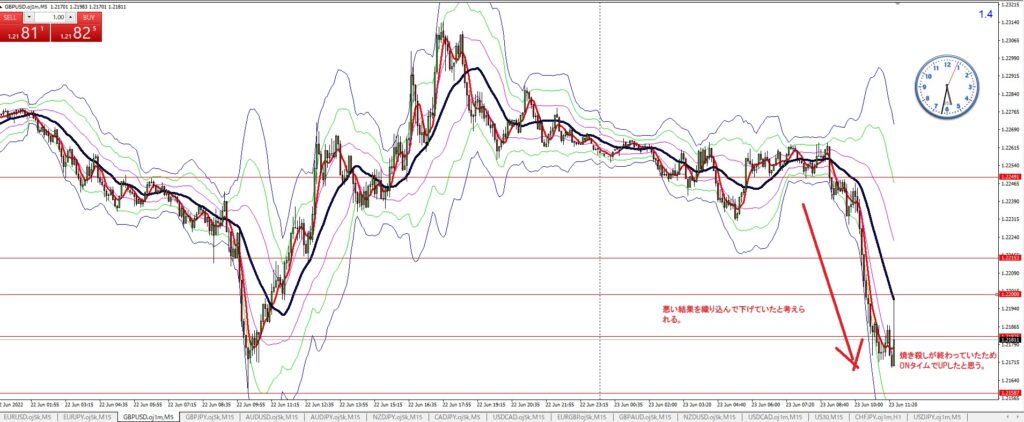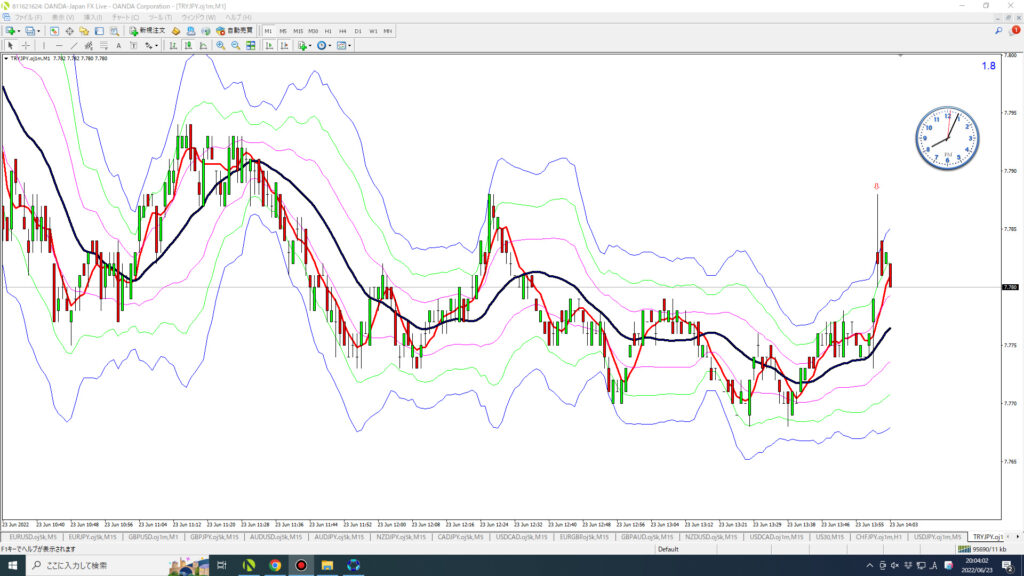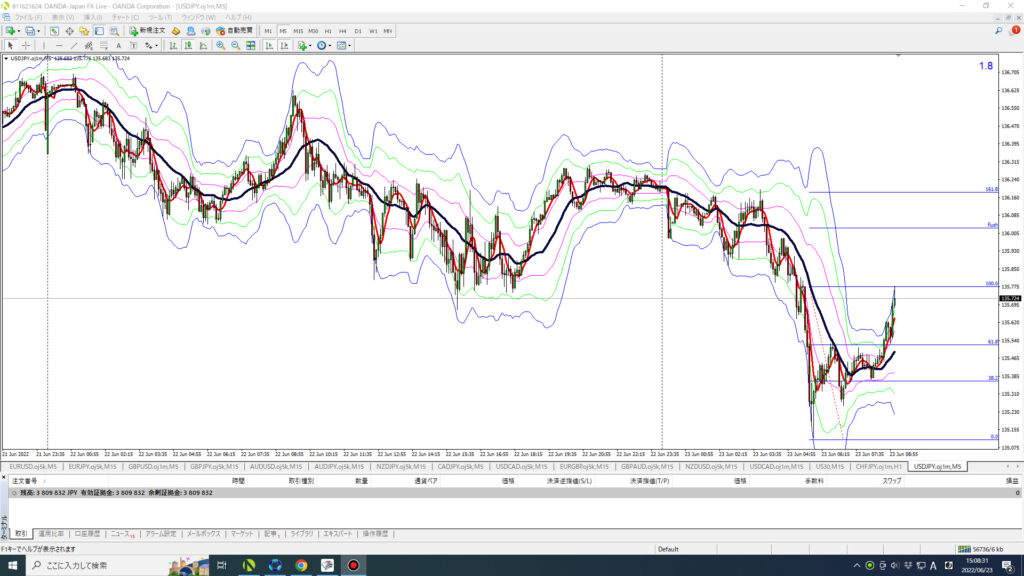今日のイベント
16:30 ドイツ 製造業PMI 54.0
17:30 EU 製造業PMI 53.9
17:30 英国 製造業PMI 53.7 →IFDで行く。なぜなら前回55.0→54.6で1分で60PIPSも落ち、値動き活発のため、同じことが起こるだろうから。
1.53.7よりよかった時→ 一時的は上がるだろう。その後は行ってこいで前回高値で止まるだろう。そこでショート。ショートの理由は
すでにCPIが高いことは織り込んでいると思うから、乖離がなくなったら下がるだろう。
2.53.7=53.7のとき 利食いと損切が乱高下する。上に行った場合は前回高値で止まるだろう。そこでショート。ショートの理由はすでに
CPIが高いことは織り込んでいると思うから、乖離がなくなったら下がるだろう。
3.53.7より悪かった時→ 一下がるだろう。乖離が埋まっていってこい。前回高値で止まるだろう。そこでショート。
行ってこいしなければ下がりっぱなしなので入れない。
今回は最終的には下がっていくと想定している。
17:30 英国 サービス業PMI 53.7 53.4。悪い結果も上昇した。悪い結果を織り込んで下げていたと考えられる。
20:00 トルコ 政策金利 14.0% 14.0で動かず。
23:00 パウエル議会証言 2日目
27:00 BOM メキシコペソ 政策金利
メモ :なぜ動いたかがわからないと、入れないし、こういうニュースが出たらこうなるだろうという想定で入るのはあり。
17:30 英国 サービス業PMI 53.7 53.4。悪い結果も上昇した。悪い結果を織り込んで下げていたと考えられる。焼き殺しが終わっていたため
ONタイムでUPしたと思う。

20:00 トルコ 政策金利 14.0% 14.0で動かず。

14:35 元財務長官の発言で急落売りが終わったと思い買戻しが入るだろうから、試しで0.1ロットのUSDJPYを買った。ー>勘違い。急落ではなく上昇したのだから、下は単なる偶然で勝ち。

「為替介入の可能性排除できない」と中尾元財務官、円が上昇
占部絵美、野原良明2022年6月23日 11:42 JST 更新日時 2022年6月23日 14:39 JST
- 協調介入「極めて難しい」、当局者とは話しておらず個人的な見解
- 外貨準備は投機的動き抑えるため、単独介入も「ある程度役に立つ」
元財務官でみずほリサーチ&テクノロジーズの中尾武彦理事長は23日、円が対ドルで24年ぶり安値を更新する中、「為替介入の可能性は排除できない」との見解を示した。ブルームバーグテレビジョンとの英語インタビューで述べた。
米国との協調介入については「極めて難しい」と語った。日本の当局者とは話しておらず、個人的な見解だという。

中尾氏の発言後、外国為替市場では円が対ドルで1ドル=135円台前半に上昇した。発言前は135円台後半で推移していた。
中尾氏は番組前の日本語での取材に対し、外貨準備は「自国通貨がアタックされて急速に為替が安くなったりするときのために持っている」と指摘。単独の介入でも、投機的な動きを抑えるために「ある程度役に立つ」と語った。
中尾氏が財務官在職中(2011年8月-13年3月)に円が戦後最高値の75円台を付けた際、政府・日本銀行は円売り介入を実施した。
米当局は介入に対して「直ちに非難しない」「黙認する」「許容する」といったレベルで反応するが、当時は「サポートはしないが、直ちに非難はしなかった」と振り返った。米国はむしろ他国による自国通貨安誘導の方を嫌うため、「ドル買い介入の方が一般的に難しい」とも語った。
政府と日銀が3者会合を開き、急速な円安進行に対して憂慮を表明した10日、米財務省は外国為替報告書で、日本を監視対象国に引き続き指定した。為替介入は「適切な事前協議を伴う、非常に例外的な状況に限定されるべきだ」と従来の表現を用いて介入をけん制している。

日銀が海外中央銀行による相次ぐ利上げの潮流に乗らず、6月の金融政策決定会合で緩和策の維持を決めたことを受け、為替市場では円売り圧力が強まった。22日には136円71銭と24年ぶりの安値を更新。円安が物価上昇に拍車をかける状況で迎える7月の参院選は、日銀の金融政策も争点となっている。
中尾氏は、「今の円安は金融政策のスタンスの差に応じた行き過ぎた動きだ」と指摘。円安に加え、財政規律の緩み、金融機関の収益、市場機能の低下など、緩和継続に伴う負の側面が出てきているという。政策変更の内容や時期については「難しい判断だとしか言えない」と語った。
円安は日本経済にプラスという考え方に関しては、「明らかに間違っている」と主張。自国通貨安によってドル建ての所得や資産価格が下がり「日本は貧しくなった」と語った。日本にとって最悪のシナリオは「円が売られ、株が売られ、国債が売られ、金利が急上昇して、国債が売れなくなってロールオーバー(借り換え)ができなくなる状況だ」と述べた。
| 関連記事 |
|---|
Why Fracking Won’t Solve the Global Oil and Gas Squeeze
Oil Slides as Recession Concerns Hit Commodities MarketBy
David Wethe2022年6月23日 5:48 JSTFrom
Listen to this article
4:53
Share this article
Follow the authors@DavidWethe+ Get alerts forDavid Wethe
In this article
CL1WTI Crude105.87USD/bbl.-0.32-0.30%NG1Generic 1st 'NG' Future6.72USD/MMBtu-0.14-2.06%XW1Generic 1st 'XW' Future370.00USD/MT+3.75+1.02%Open
A tsunami of oil and gas from the technique called fracking has made the US the world’s biggest producer of both, giving the country the energy independence its leaders have sought for decades and upending the geopolitics of the world energy trade. Now, with the world crying out for more oil and gas, American frackers are theoretically in a position to provide it. Instead, they are riding the brakes, having changed their business models to focus on generating profits for investors rather than increasing production.
1. What is fracking?
Fracking, or hydraulic fracturing, was first used commercially in 1949 in the oil- and gas-rich US state of Oklahoma. The technique involves forcing water mixed with sand and chemicals into a well to create fissures in underground rocks known as shale so that oil or gas trapped inside can be captured. Advances in another technique, horizontal drilling, came in the early 1980s and opened up access to thin layers of shale deep underground. The subsequent exploitation of the Barnett Shale formation in Texas proved large-scale fracking was economically viable.
2. How has fracking changed the energy trade?
US oil and gas output has more than doubled in two decades, largely thanks to shale-rich areas such as the Permian Basin, which stretches from Texas to New Mexico and alone pumps more oil than most OPEC nations. That’s enabled the world’s largest economy to export fossil fuels at a pace unthinkable only a few years ago. America’s new dominance undercuts OPEC’s ability to control the oil market. OPEC tried to drive North American frackers out of business starting in 2014 by flooding the market with crude, provoking a price crash. Although some frackers went bust, overall they proved nimble, innovating to reduce production costs and stay alive. The abundance of shale gas has helped the US cut its use of coal, the most polluting fossil fuel, nearly in half since 2008. What’s more, American gas is now available on world markets, thanks to a process that enables it to be super-cooled into liquefied natural gas and transported via ship.
3. Why are US frackers holding back now?
Recent oil busts, exacerbated by the pandemic, drove many producers to bankruptcy. Coming out of the wreckage, investors demanded that publicly traded producers show more austerity and return profits to shareholders rather than plow it all back into drilling. Some of the biggest producers in the US are generally keeping annual production growth to 5% or less. The service providers who are hired to do the actual fracking are also embracing the chance to reward their shareholders with greater returns. They are holding off on ordering more gear to avoid being stuck with excess equipment as they were when previous booms ended.
4. Where else is fracking done?
Canada was the first country to thoroughly embrace shale extraction outside the US. It’s also spreading to Argentina, Australia, China and Saudi Arabia. The enormous amounts of sand and water required are a limitation in many places. Fracking faces bans or opposition in numerous countries, including the UK, where the government has placed a moratorium on new permits.
5. What are the objections to fracking?
Opposition within communities often focuses on water concerns. The copious amount of water needed for fracking — as much as 16 million gallons per well in the US — can threaten local supplies, and concerns have been raised that shale operations may contaminate water sources. Fracking and, more commonly, the pumping of wastewater into wells, have been connected to earthquakes. They’ve been mostly small, but temblors in China’s shale hub in Sichuan province killed two people and damaged 11,000 homes in early 2019. More broadly, critics of fracking say that by making oil and gas more plentiful, it has reduced incentives to invest in a switch to renewable energy, even as climate scientists call for speeding the change.
6. What do defenders say?
They note that a growing number of companies are reusing the water employed to frack a well multiple times and are reducing emissions from their operations by utilizing electric-powered vehicles instead of the diesel-powered fleets typical in the oil and gas industry. They point to the jobs created by fracking and the cleaner air natural gas produces where it replaces coal. Their larger argument is that, compared with coal, gas emits half as much carbon dioxide, the most important greenhouse gas. There’s a robust debate as to how much the carbon savings are offset by leaks throughout the natural gas supply chain of methane, a more potent greenhouse gas than carbon dioxide. Supporters tout natural gas as a “bridge fuel” that will ease the transition to renewables, supplying power when wind and solar sources don’t, until sufficient storage capacity is built.